Analyzing Leadership and Management in the Context of Marks & Spencer
VerifiedAdded on 2023/01/05
|10
|2544
|78
Report
AI Summary
This report provides a comprehensive analysis of leadership and management practices at Marks & Spencer. It begins with an introduction to the roles of management and leadership, emphasizing their importance for organizational development. The main body delves into the application of motivational theories, such as McClelland's Needs Theory and Vroom's Expectancy Theory, to foster effective teamwork, and examines different management styles, particularly participative management. The report then assesses the impact of leadership and management behaviors on achieving the company's vision and mission, detailing behaviors like building trust, encouraging innovation, and reflecting commitment. Finally, the report discusses the facilitation of change within M&S, focusing on Kurt Lewin's change model and its application in unfreezing, changing, and refreezing organizational processes. The conclusion summarizes the key findings, highlighting the critical role of leadership and management in organizational success, employee motivation, and the effective implementation of change.

Mark & Spencer
Paraphrase This Document
Need a fresh take? Get an instant paraphrase of this document with our AI Paraphraser
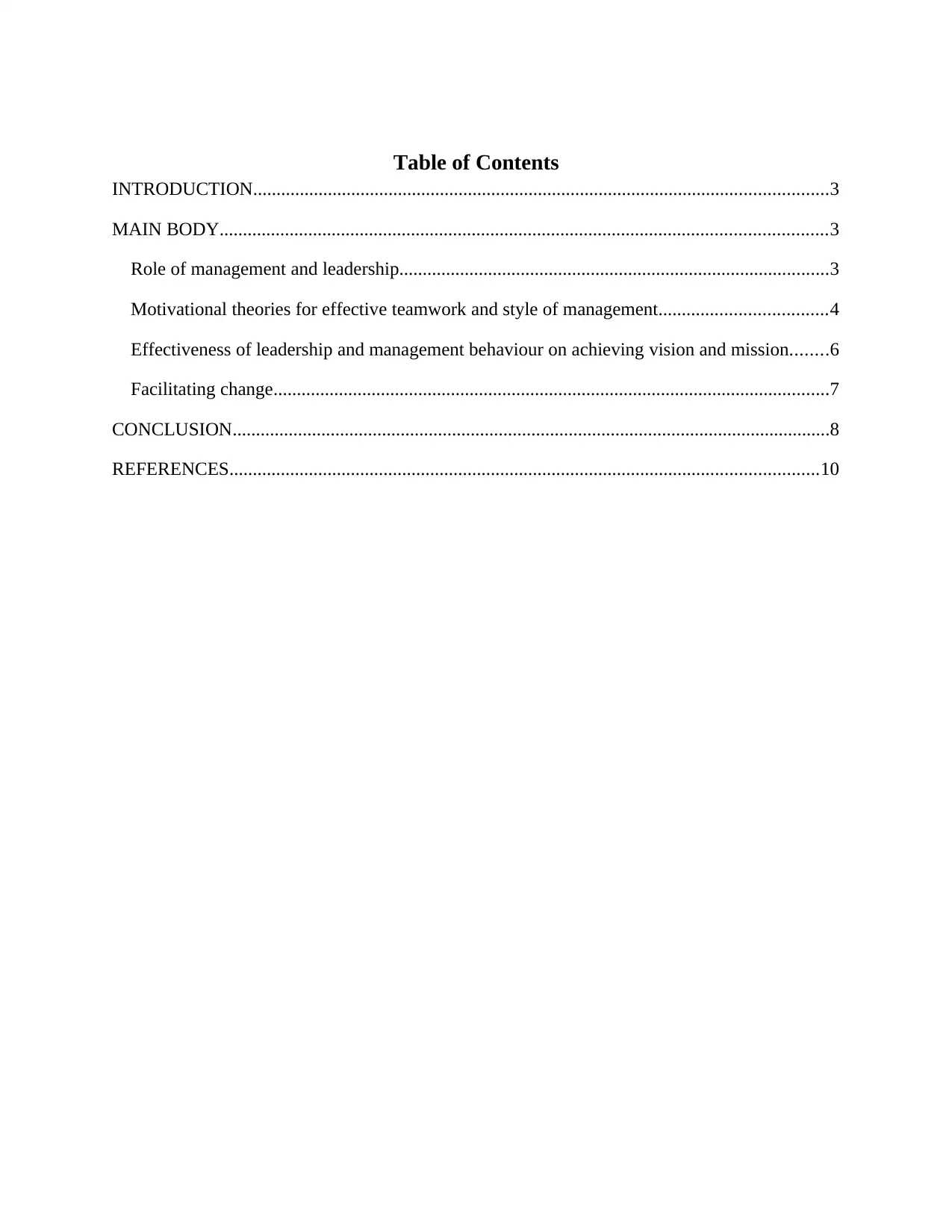
Table of Contents
INTRODUCTION...........................................................................................................................3
MAIN BODY..................................................................................................................................3
Role of management and leadership............................................................................................3
Motivational theories for effective teamwork and style of management....................................4
Effectiveness of leadership and management behaviour on achieving vision and mission........6
Facilitating change.......................................................................................................................7
CONCLUSION................................................................................................................................8
REFERENCES..............................................................................................................................10
INTRODUCTION...........................................................................................................................3
MAIN BODY..................................................................................................................................3
Role of management and leadership............................................................................................3
Motivational theories for effective teamwork and style of management....................................4
Effectiveness of leadership and management behaviour on achieving vision and mission........6
Facilitating change.......................................................................................................................7
CONCLUSION................................................................................................................................8
REFERENCES..............................................................................................................................10
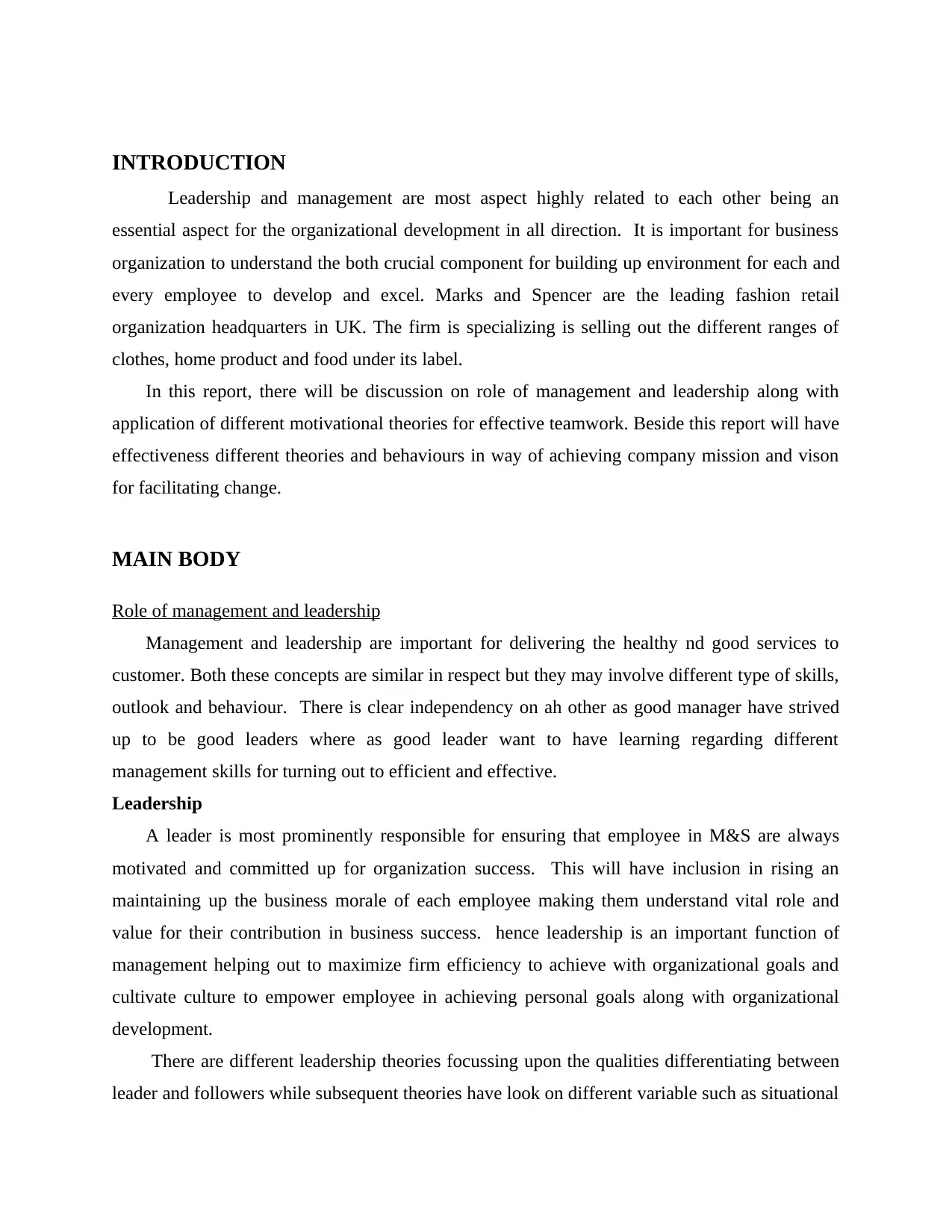
INTRODUCTION
Leadership and management are most aspect highly related to each other being an
essential aspect for the organizational development in all direction. It is important for business
organization to understand the both crucial component for building up environment for each and
every employee to develop and excel. Marks and Spencer are the leading fashion retail
organization headquarters in UK. The firm is specializing is selling out the different ranges of
clothes, home product and food under its label.
In this report, there will be discussion on role of management and leadership along with
application of different motivational theories for effective teamwork. Beside this report will have
effectiveness different theories and behaviours in way of achieving company mission and vison
for facilitating change.
MAIN BODY
Role of management and leadership
Management and leadership are important for delivering the healthy nd good services to
customer. Both these concepts are similar in respect but they may involve different type of skills,
outlook and behaviour. There is clear independency on ah other as good manager have strived
up to be good leaders where as good leader want to have learning regarding different
management skills for turning out to efficient and effective.
Leadership
A leader is most prominently responsible for ensuring that employee in M&S are always
motivated and committed up for organization success. This will have inclusion in rising an
maintaining up the business morale of each employee making them understand vital role and
value for their contribution in business success. hence leadership is an important function of
management helping out to maximize firm efficiency to achieve with organizational goals and
cultivate culture to empower employee in achieving personal goals along with organizational
development.
There are different leadership theories focussing upon the qualities differentiating between
leader and followers while subsequent theories have look on different variable such as situational
Leadership and management are most aspect highly related to each other being an
essential aspect for the organizational development in all direction. It is important for business
organization to understand the both crucial component for building up environment for each and
every employee to develop and excel. Marks and Spencer are the leading fashion retail
organization headquarters in UK. The firm is specializing is selling out the different ranges of
clothes, home product and food under its label.
In this report, there will be discussion on role of management and leadership along with
application of different motivational theories for effective teamwork. Beside this report will have
effectiveness different theories and behaviours in way of achieving company mission and vison
for facilitating change.
MAIN BODY
Role of management and leadership
Management and leadership are important for delivering the healthy nd good services to
customer. Both these concepts are similar in respect but they may involve different type of skills,
outlook and behaviour. There is clear independency on ah other as good manager have strived
up to be good leaders where as good leader want to have learning regarding different
management skills for turning out to efficient and effective.
Leadership
A leader is most prominently responsible for ensuring that employee in M&S are always
motivated and committed up for organization success. This will have inclusion in rising an
maintaining up the business morale of each employee making them understand vital role and
value for their contribution in business success. hence leadership is an important function of
management helping out to maximize firm efficiency to achieve with organizational goals and
cultivate culture to empower employee in achieving personal goals along with organizational
development.
There are different leadership theories focussing upon the qualities differentiating between
leader and followers while subsequent theories have look on different variable such as situational
⊘ This is a preview!⊘
Do you want full access?
Subscribe today to unlock all pages.

Trusted by 1+ million students worldwide
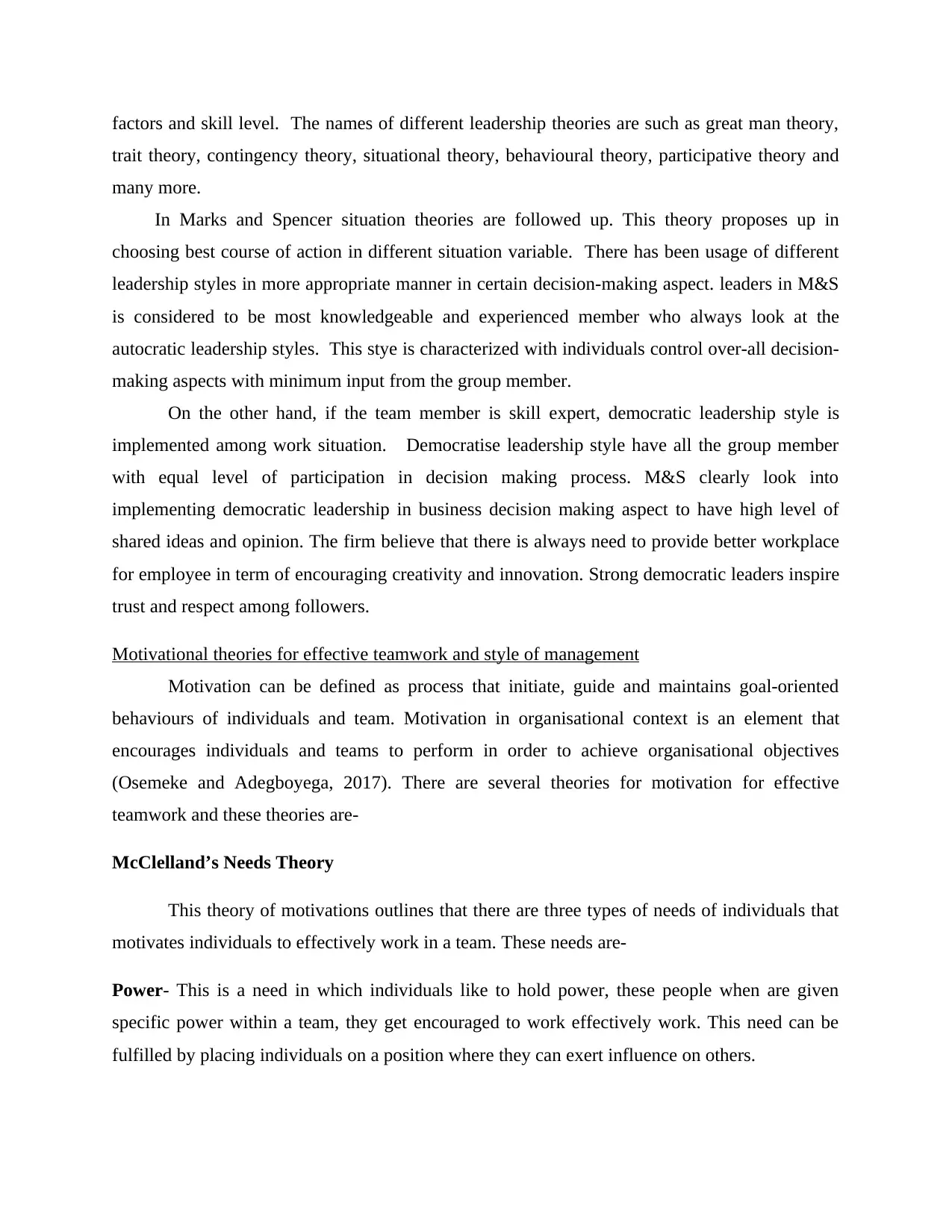
factors and skill level. The names of different leadership theories are such as great man theory,
trait theory, contingency theory, situational theory, behavioural theory, participative theory and
many more.
In Marks and Spencer situation theories are followed up. This theory proposes up in
choosing best course of action in different situation variable. There has been usage of different
leadership styles in more appropriate manner in certain decision-making aspect. leaders in M&S
is considered to be most knowledgeable and experienced member who always look at the
autocratic leadership styles. This stye is characterized with individuals control over-all decision-
making aspects with minimum input from the group member.
On the other hand, if the team member is skill expert, democratic leadership style is
implemented among work situation. Democratise leadership style have all the group member
with equal level of participation in decision making process. M&S clearly look into
implementing democratic leadership in business decision making aspect to have high level of
shared ideas and opinion. The firm believe that there is always need to provide better workplace
for employee in term of encouraging creativity and innovation. Strong democratic leaders inspire
trust and respect among followers.
Motivational theories for effective teamwork and style of management
Motivation can be defined as process that initiate, guide and maintains goal-oriented
behaviours of individuals and team. Motivation in organisational context is an element that
encourages individuals and teams to perform in order to achieve organisational objectives
(Osemeke and Adegboyega, 2017). There are several theories for motivation for effective
teamwork and these theories are-
McClelland’s Needs Theory
This theory of motivations outlines that there are three types of needs of individuals that
motivates individuals to effectively work in a team. These needs are-
Power- This is a need in which individuals like to hold power, these people when are given
specific power within a team, they get encouraged to work effectively work. This need can be
fulfilled by placing individuals on a position where they can exert influence on others.
trait theory, contingency theory, situational theory, behavioural theory, participative theory and
many more.
In Marks and Spencer situation theories are followed up. This theory proposes up in
choosing best course of action in different situation variable. There has been usage of different
leadership styles in more appropriate manner in certain decision-making aspect. leaders in M&S
is considered to be most knowledgeable and experienced member who always look at the
autocratic leadership styles. This stye is characterized with individuals control over-all decision-
making aspects with minimum input from the group member.
On the other hand, if the team member is skill expert, democratic leadership style is
implemented among work situation. Democratise leadership style have all the group member
with equal level of participation in decision making process. M&S clearly look into
implementing democratic leadership in business decision making aspect to have high level of
shared ideas and opinion. The firm believe that there is always need to provide better workplace
for employee in term of encouraging creativity and innovation. Strong democratic leaders inspire
trust and respect among followers.
Motivational theories for effective teamwork and style of management
Motivation can be defined as process that initiate, guide and maintains goal-oriented
behaviours of individuals and team. Motivation in organisational context is an element that
encourages individuals and teams to perform in order to achieve organisational objectives
(Osemeke and Adegboyega, 2017). There are several theories for motivation for effective
teamwork and these theories are-
McClelland’s Needs Theory
This theory of motivations outlines that there are three types of needs of individuals that
motivates individuals to effectively work in a team. These needs are-
Power- This is a need in which individuals like to hold power, these people when are given
specific power within a team, they get encouraged to work effectively work. This need can be
fulfilled by placing individuals on a position where they can exert influence on others.
Paraphrase This Document
Need a fresh take? Get an instant paraphrase of this document with our AI Paraphraser
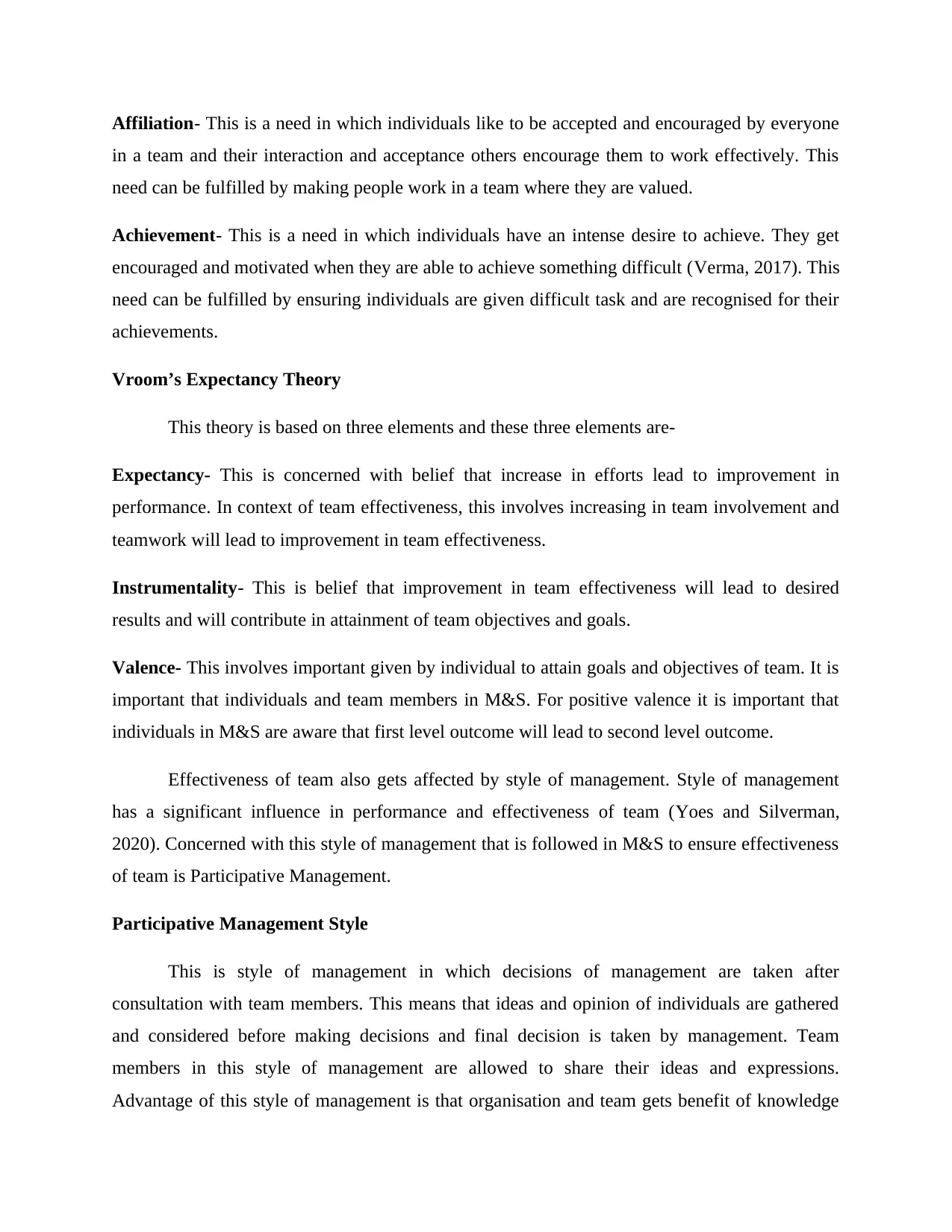
Affiliation- This is a need in which individuals like to be accepted and encouraged by everyone
in a team and their interaction and acceptance others encourage them to work effectively. This
need can be fulfilled by making people work in a team where they are valued.
Achievement- This is a need in which individuals have an intense desire to achieve. They get
encouraged and motivated when they are able to achieve something difficult (Verma, 2017). This
need can be fulfilled by ensuring individuals are given difficult task and are recognised for their
achievements.
Vroom’s Expectancy Theory
This theory is based on three elements and these three elements are-
Expectancy- This is concerned with belief that increase in efforts lead to improvement in
performance. In context of team effectiveness, this involves increasing in team involvement and
teamwork will lead to improvement in team effectiveness.
Instrumentality- This is belief that improvement in team effectiveness will lead to desired
results and will contribute in attainment of team objectives and goals.
Valence- This involves important given by individual to attain goals and objectives of team. It is
important that individuals and team members in M&S. For positive valence it is important that
individuals in M&S are aware that first level outcome will lead to second level outcome.
Effectiveness of team also gets affected by style of management. Style of management
has a significant influence in performance and effectiveness of team (Yoes and Silverman,
2020). Concerned with this style of management that is followed in M&S to ensure effectiveness
of team is Participative Management.
Participative Management Style
This is style of management in which decisions of management are taken after
consultation with team members. This means that ideas and opinion of individuals are gathered
and considered before making decisions and final decision is taken by management. Team
members in this style of management are allowed to share their ideas and expressions.
Advantage of this style of management is that organisation and team gets benefit of knowledge
in a team and their interaction and acceptance others encourage them to work effectively. This
need can be fulfilled by making people work in a team where they are valued.
Achievement- This is a need in which individuals have an intense desire to achieve. They get
encouraged and motivated when they are able to achieve something difficult (Verma, 2017). This
need can be fulfilled by ensuring individuals are given difficult task and are recognised for their
achievements.
Vroom’s Expectancy Theory
This theory is based on three elements and these three elements are-
Expectancy- This is concerned with belief that increase in efforts lead to improvement in
performance. In context of team effectiveness, this involves increasing in team involvement and
teamwork will lead to improvement in team effectiveness.
Instrumentality- This is belief that improvement in team effectiveness will lead to desired
results and will contribute in attainment of team objectives and goals.
Valence- This involves important given by individual to attain goals and objectives of team. It is
important that individuals and team members in M&S. For positive valence it is important that
individuals in M&S are aware that first level outcome will lead to second level outcome.
Effectiveness of team also gets affected by style of management. Style of management
has a significant influence in performance and effectiveness of team (Yoes and Silverman,
2020). Concerned with this style of management that is followed in M&S to ensure effectiveness
of team is Participative Management.
Participative Management Style
This is style of management in which decisions of management are taken after
consultation with team members. This means that ideas and opinion of individuals are gathered
and considered before making decisions and final decision is taken by management. Team
members in this style of management are allowed to share their ideas and expressions.
Advantage of this style of management is that organisation and team gets benefit of knowledge
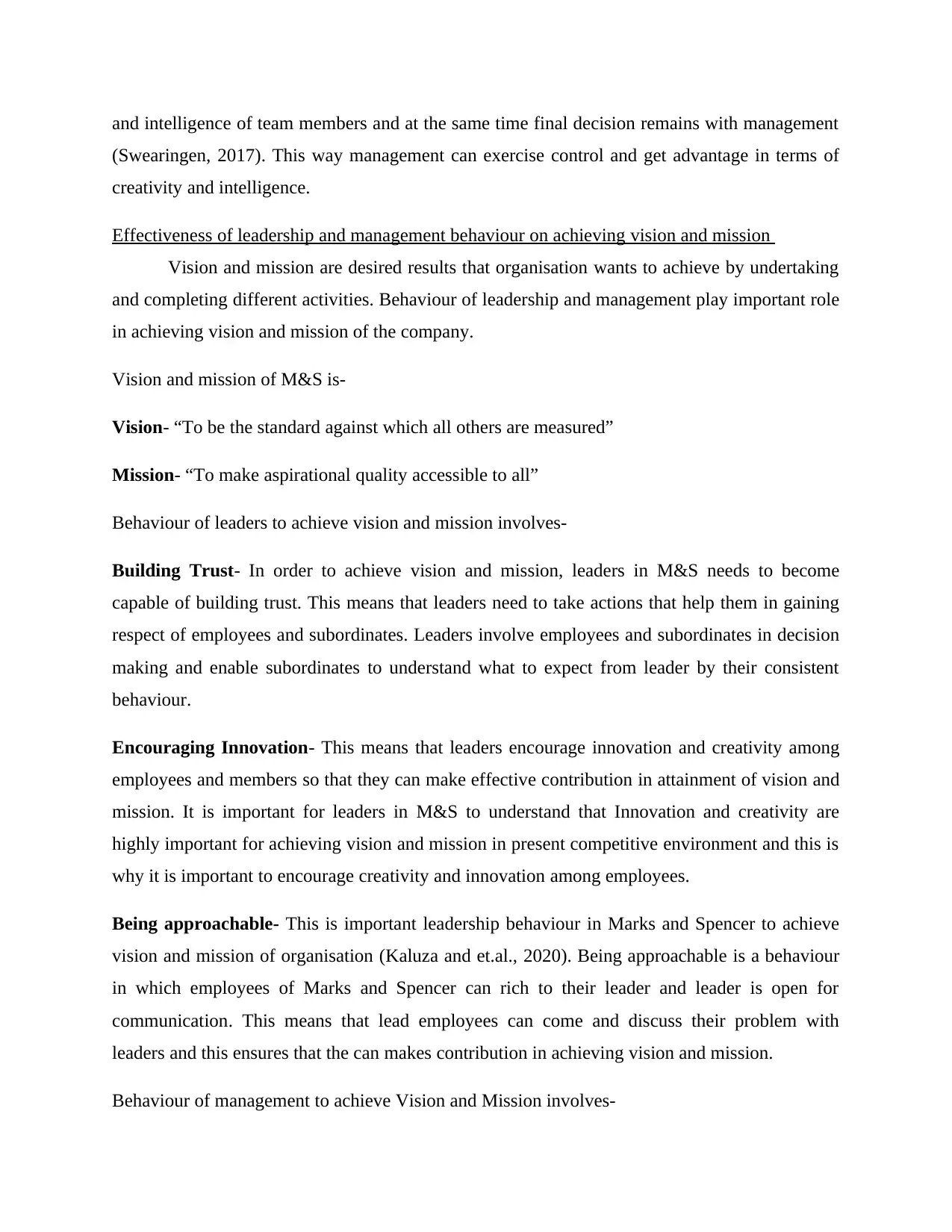
and intelligence of team members and at the same time final decision remains with management
(Swearingen, 2017). This way management can exercise control and get advantage in terms of
creativity and intelligence.
Effectiveness of leadership and management behaviour on achieving vision and mission
Vision and mission are desired results that organisation wants to achieve by undertaking
and completing different activities. Behaviour of leadership and management play important role
in achieving vision and mission of the company.
Vision and mission of M&S is-
Vision- “To be the standard against which all others are measured”
Mission- “To make aspirational quality accessible to all”
Behaviour of leaders to achieve vision and mission involves-
Building Trust- In order to achieve vision and mission, leaders in M&S needs to become
capable of building trust. This means that leaders need to take actions that help them in gaining
respect of employees and subordinates. Leaders involve employees and subordinates in decision
making and enable subordinates to understand what to expect from leader by their consistent
behaviour.
Encouraging Innovation- This means that leaders encourage innovation and creativity among
employees and members so that they can make effective contribution in attainment of vision and
mission. It is important for leaders in M&S to understand that Innovation and creativity are
highly important for achieving vision and mission in present competitive environment and this is
why it is important to encourage creativity and innovation among employees.
Being approachable- This is important leadership behaviour in Marks and Spencer to achieve
vision and mission of organisation (Kaluza and et.al., 2020). Being approachable is a behaviour
in which employees of Marks and Spencer can rich to their leader and leader is open for
communication. This means that lead employees can come and discuss their problem with
leaders and this ensures that the can makes contribution in achieving vision and mission.
Behaviour of management to achieve Vision and Mission involves-
(Swearingen, 2017). This way management can exercise control and get advantage in terms of
creativity and intelligence.
Effectiveness of leadership and management behaviour on achieving vision and mission
Vision and mission are desired results that organisation wants to achieve by undertaking
and completing different activities. Behaviour of leadership and management play important role
in achieving vision and mission of the company.
Vision and mission of M&S is-
Vision- “To be the standard against which all others are measured”
Mission- “To make aspirational quality accessible to all”
Behaviour of leaders to achieve vision and mission involves-
Building Trust- In order to achieve vision and mission, leaders in M&S needs to become
capable of building trust. This means that leaders need to take actions that help them in gaining
respect of employees and subordinates. Leaders involve employees and subordinates in decision
making and enable subordinates to understand what to expect from leader by their consistent
behaviour.
Encouraging Innovation- This means that leaders encourage innovation and creativity among
employees and members so that they can make effective contribution in attainment of vision and
mission. It is important for leaders in M&S to understand that Innovation and creativity are
highly important for achieving vision and mission in present competitive environment and this is
why it is important to encourage creativity and innovation among employees.
Being approachable- This is important leadership behaviour in Marks and Spencer to achieve
vision and mission of organisation (Kaluza and et.al., 2020). Being approachable is a behaviour
in which employees of Marks and Spencer can rich to their leader and leader is open for
communication. This means that lead employees can come and discuss their problem with
leaders and this ensures that the can makes contribution in achieving vision and mission.
Behaviour of management to achieve Vision and Mission involves-
⊘ This is a preview!⊘
Do you want full access?
Subscribe today to unlock all pages.

Trusted by 1+ million students worldwide
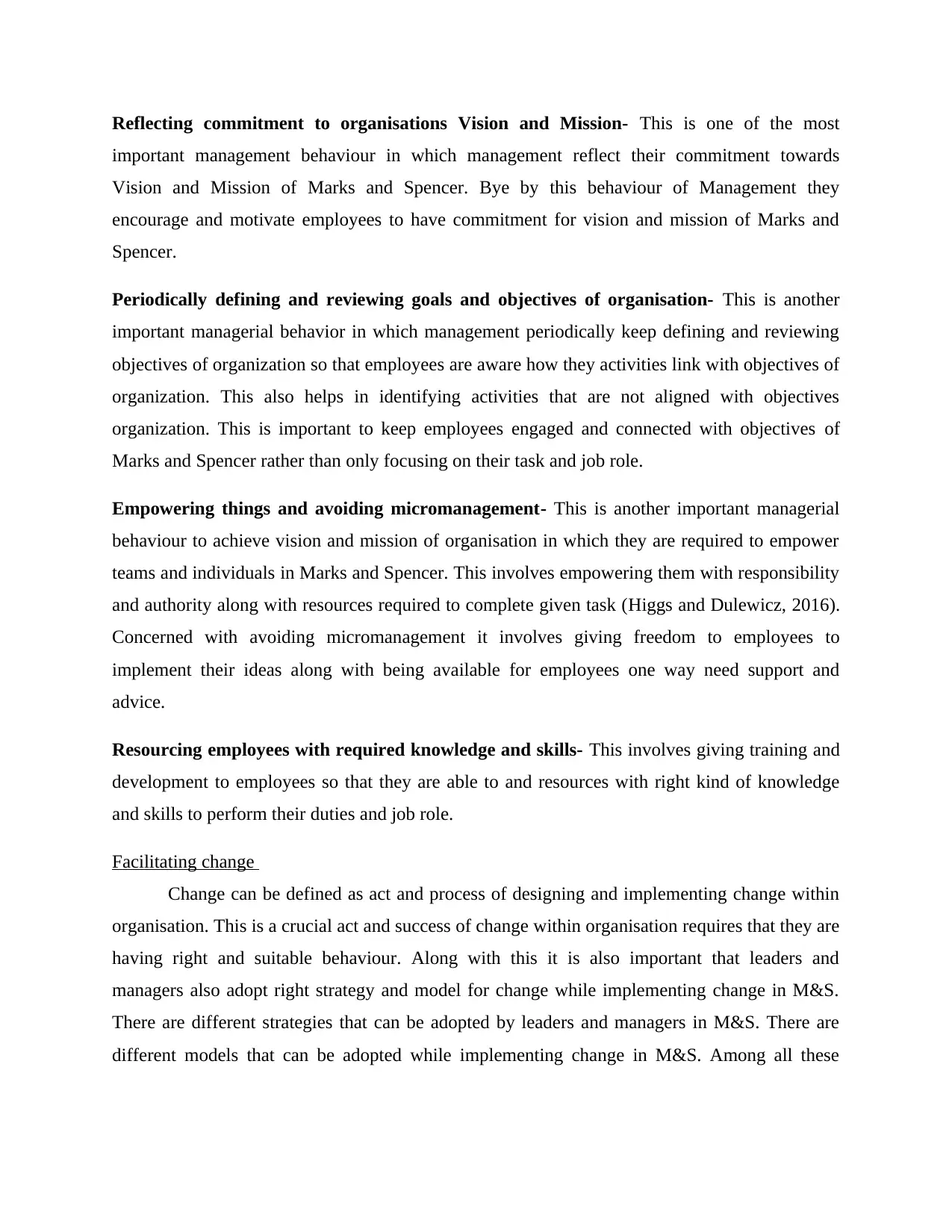
Reflecting commitment to organisations Vision and Mission- This is one of the most
important management behaviour in which management reflect their commitment towards
Vision and Mission of Marks and Spencer. Bye by this behaviour of Management they
encourage and motivate employees to have commitment for vision and mission of Marks and
Spencer.
Periodically defining and reviewing goals and objectives of organisation- This is another
important managerial behavior in which management periodically keep defining and reviewing
objectives of organization so that employees are aware how they activities link with objectives of
organization. This also helps in identifying activities that are not aligned with objectives
organization. This is important to keep employees engaged and connected with objectives of
Marks and Spencer rather than only focusing on their task and job role.
Empowering things and avoiding micromanagement- This is another important managerial
behaviour to achieve vision and mission of organisation in which they are required to empower
teams and individuals in Marks and Spencer. This involves empowering them with responsibility
and authority along with resources required to complete given task (Higgs and Dulewicz, 2016).
Concerned with avoiding micromanagement it involves giving freedom to employees to
implement their ideas along with being available for employees one way need support and
advice.
Resourcing employees with required knowledge and skills- This involves giving training and
development to employees so that they are able to and resources with right kind of knowledge
and skills to perform their duties and job role.
Facilitating change
Change can be defined as act and process of designing and implementing change within
organisation. This is a crucial act and success of change within organisation requires that they are
having right and suitable behaviour. Along with this it is also important that leaders and
managers also adopt right strategy and model for change while implementing change in M&S.
There are different strategies that can be adopted by leaders and managers in M&S. There are
different models that can be adopted while implementing change in M&S. Among all these
important management behaviour in which management reflect their commitment towards
Vision and Mission of Marks and Spencer. Bye by this behaviour of Management they
encourage and motivate employees to have commitment for vision and mission of Marks and
Spencer.
Periodically defining and reviewing goals and objectives of organisation- This is another
important managerial behavior in which management periodically keep defining and reviewing
objectives of organization so that employees are aware how they activities link with objectives of
organization. This also helps in identifying activities that are not aligned with objectives
organization. This is important to keep employees engaged and connected with objectives of
Marks and Spencer rather than only focusing on their task and job role.
Empowering things and avoiding micromanagement- This is another important managerial
behaviour to achieve vision and mission of organisation in which they are required to empower
teams and individuals in Marks and Spencer. This involves empowering them with responsibility
and authority along with resources required to complete given task (Higgs and Dulewicz, 2016).
Concerned with avoiding micromanagement it involves giving freedom to employees to
implement their ideas along with being available for employees one way need support and
advice.
Resourcing employees with required knowledge and skills- This involves giving training and
development to employees so that they are able to and resources with right kind of knowledge
and skills to perform their duties and job role.
Facilitating change
Change can be defined as act and process of designing and implementing change within
organisation. This is a crucial act and success of change within organisation requires that they are
having right and suitable behaviour. Along with this it is also important that leaders and
managers also adopt right strategy and model for change while implementing change in M&S.
There are different strategies that can be adopted by leaders and managers in M&S. There are
different models that can be adopted while implementing change in M&S. Among all these
Paraphrase This Document
Need a fresh take? Get an instant paraphrase of this document with our AI Paraphraser
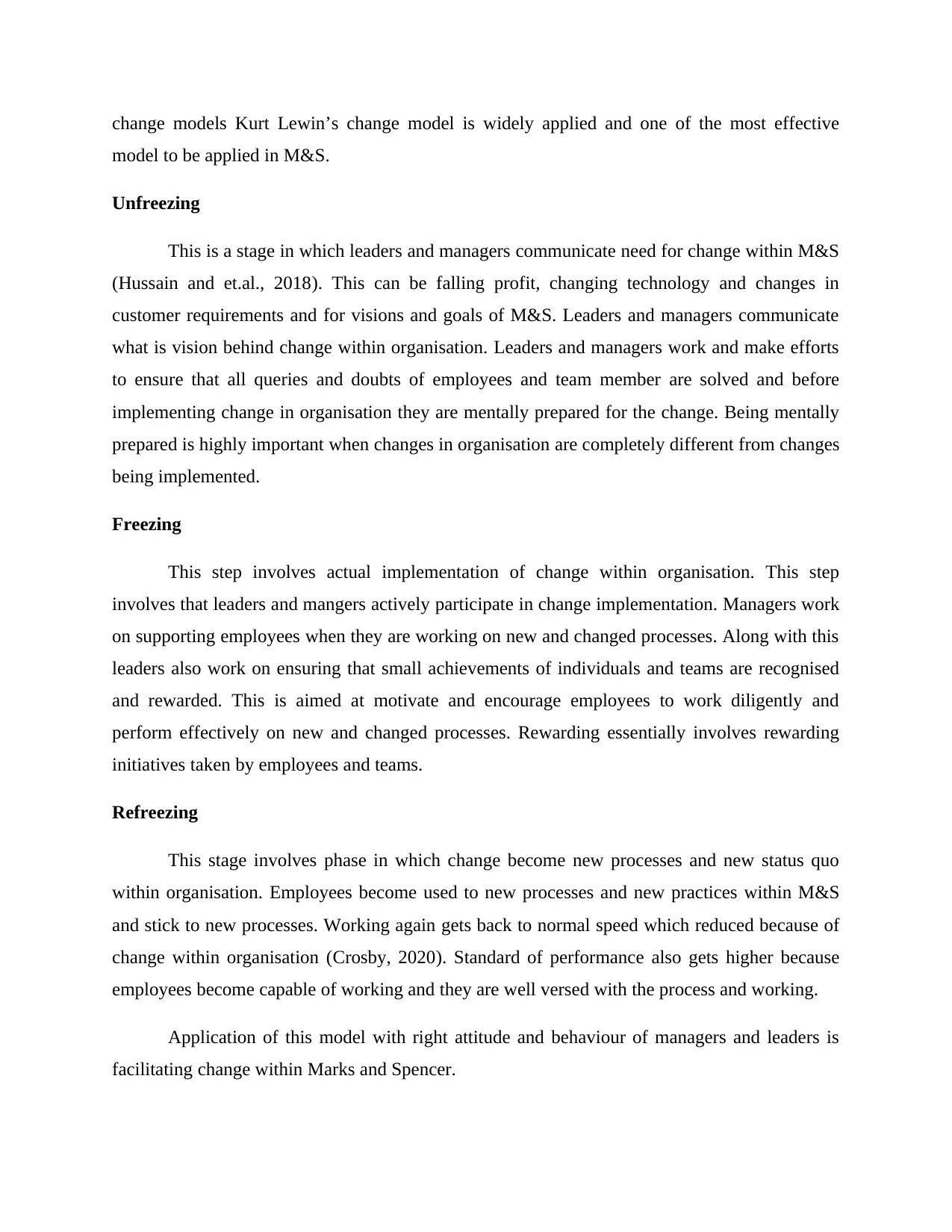
change models Kurt Lewin’s change model is widely applied and one of the most effective
model to be applied in M&S.
Unfreezing
This is a stage in which leaders and managers communicate need for change within M&S
(Hussain and et.al., 2018). This can be falling profit, changing technology and changes in
customer requirements and for visions and goals of M&S. Leaders and managers communicate
what is vision behind change within organisation. Leaders and managers work and make efforts
to ensure that all queries and doubts of employees and team member are solved and before
implementing change in organisation they are mentally prepared for the change. Being mentally
prepared is highly important when changes in organisation are completely different from changes
being implemented.
Freezing
This step involves actual implementation of change within organisation. This step
involves that leaders and mangers actively participate in change implementation. Managers work
on supporting employees when they are working on new and changed processes. Along with this
leaders also work on ensuring that small achievements of individuals and teams are recognised
and rewarded. This is aimed at motivate and encourage employees to work diligently and
perform effectively on new and changed processes. Rewarding essentially involves rewarding
initiatives taken by employees and teams.
Refreezing
This stage involves phase in which change become new processes and new status quo
within organisation. Employees become used to new processes and new practices within M&S
and stick to new processes. Working again gets back to normal speed which reduced because of
change within organisation (Crosby, 2020). Standard of performance also gets higher because
employees become capable of working and they are well versed with the process and working.
Application of this model with right attitude and behaviour of managers and leaders is
facilitating change within Marks and Spencer.
model to be applied in M&S.
Unfreezing
This is a stage in which leaders and managers communicate need for change within M&S
(Hussain and et.al., 2018). This can be falling profit, changing technology and changes in
customer requirements and for visions and goals of M&S. Leaders and managers communicate
what is vision behind change within organisation. Leaders and managers work and make efforts
to ensure that all queries and doubts of employees and team member are solved and before
implementing change in organisation they are mentally prepared for the change. Being mentally
prepared is highly important when changes in organisation are completely different from changes
being implemented.
Freezing
This step involves actual implementation of change within organisation. This step
involves that leaders and mangers actively participate in change implementation. Managers work
on supporting employees when they are working on new and changed processes. Along with this
leaders also work on ensuring that small achievements of individuals and teams are recognised
and rewarded. This is aimed at motivate and encourage employees to work diligently and
perform effectively on new and changed processes. Rewarding essentially involves rewarding
initiatives taken by employees and teams.
Refreezing
This stage involves phase in which change become new processes and new status quo
within organisation. Employees become used to new processes and new practices within M&S
and stick to new processes. Working again gets back to normal speed which reduced because of
change within organisation (Crosby, 2020). Standard of performance also gets higher because
employees become capable of working and they are well versed with the process and working.
Application of this model with right attitude and behaviour of managers and leaders is
facilitating change within Marks and Spencer.
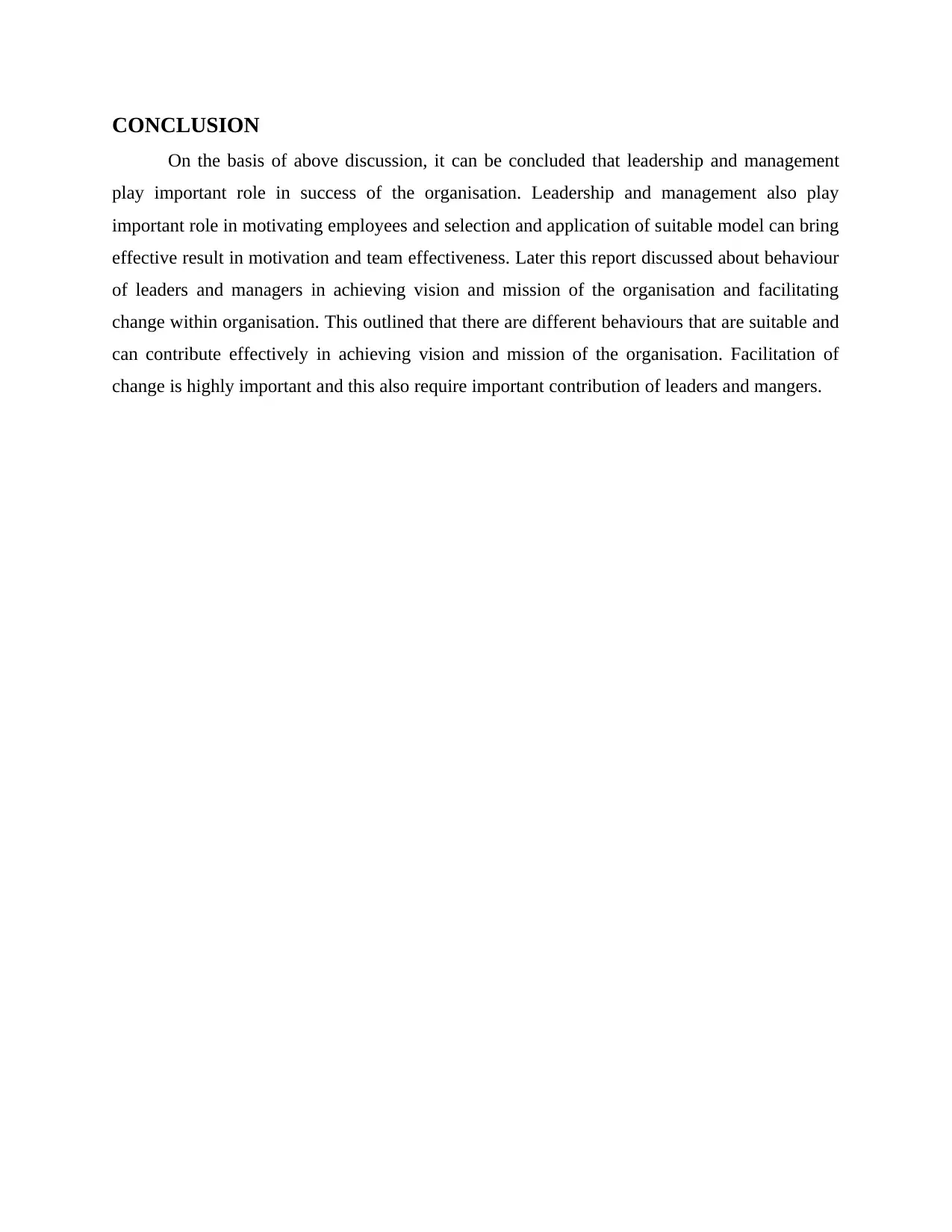
CONCLUSION
On the basis of above discussion, it can be concluded that leadership and management
play important role in success of the organisation. Leadership and management also play
important role in motivating employees and selection and application of suitable model can bring
effective result in motivation and team effectiveness. Later this report discussed about behaviour
of leaders and managers in achieving vision and mission of the organisation and facilitating
change within organisation. This outlined that there are different behaviours that are suitable and
can contribute effectively in achieving vision and mission of the organisation. Facilitation of
change is highly important and this also require important contribution of leaders and mangers.
On the basis of above discussion, it can be concluded that leadership and management
play important role in success of the organisation. Leadership and management also play
important role in motivating employees and selection and application of suitable model can bring
effective result in motivation and team effectiveness. Later this report discussed about behaviour
of leaders and managers in achieving vision and mission of the organisation and facilitating
change within organisation. This outlined that there are different behaviours that are suitable and
can contribute effectively in achieving vision and mission of the organisation. Facilitation of
change is highly important and this also require important contribution of leaders and mangers.
⊘ This is a preview!⊘
Do you want full access?
Subscribe today to unlock all pages.

Trusted by 1+ million students worldwide
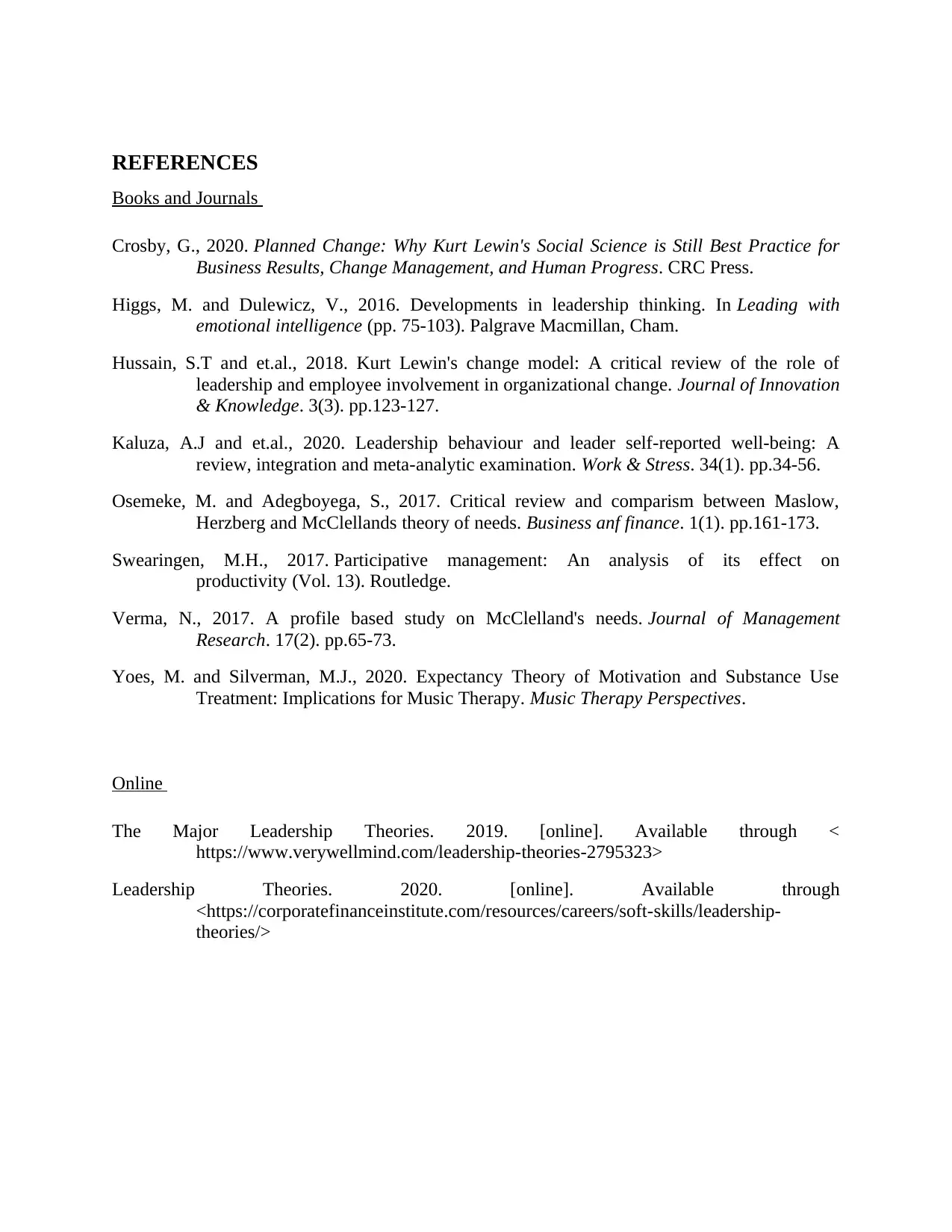
REFERENCES
Books and Journals
Crosby, G., 2020. Planned Change: Why Kurt Lewin's Social Science is Still Best Practice for
Business Results, Change Management, and Human Progress. CRC Press.
Higgs, M. and Dulewicz, V., 2016. Developments in leadership thinking. In Leading with
emotional intelligence (pp. 75-103). Palgrave Macmillan, Cham.
Hussain, S.T and et.al., 2018. Kurt Lewin's change model: A critical review of the role of
leadership and employee involvement in organizational change. Journal of Innovation
& Knowledge. 3(3). pp.123-127.
Kaluza, A.J and et.al., 2020. Leadership behaviour and leader self-reported well-being: A
review, integration and meta-analytic examination. Work & Stress. 34(1). pp.34-56.
Osemeke, M. and Adegboyega, S., 2017. Critical review and comparism between Maslow,
Herzberg and McClellands theory of needs. Business anf finance. 1(1). pp.161-173.
Swearingen, M.H., 2017. Participative management: An analysis of its effect on
productivity (Vol. 13). Routledge.
Verma, N., 2017. A profile based study on McClelland's needs. Journal of Management
Research. 17(2). pp.65-73.
Yoes, M. and Silverman, M.J., 2020. Expectancy Theory of Motivation and Substance Use
Treatment: Implications for Music Therapy. Music Therapy Perspectives.
Online
The Major Leadership Theories. 2019. [online]. Available through <
https://www.verywellmind.com/leadership-theories-2795323>
Leadership Theories. 2020. [online]. Available through
<https://corporatefinanceinstitute.com/resources/careers/soft-skills/leadership-
theories/>
Books and Journals
Crosby, G., 2020. Planned Change: Why Kurt Lewin's Social Science is Still Best Practice for
Business Results, Change Management, and Human Progress. CRC Press.
Higgs, M. and Dulewicz, V., 2016. Developments in leadership thinking. In Leading with
emotional intelligence (pp. 75-103). Palgrave Macmillan, Cham.
Hussain, S.T and et.al., 2018. Kurt Lewin's change model: A critical review of the role of
leadership and employee involvement in organizational change. Journal of Innovation
& Knowledge. 3(3). pp.123-127.
Kaluza, A.J and et.al., 2020. Leadership behaviour and leader self-reported well-being: A
review, integration and meta-analytic examination. Work & Stress. 34(1). pp.34-56.
Osemeke, M. and Adegboyega, S., 2017. Critical review and comparism between Maslow,
Herzberg and McClellands theory of needs. Business anf finance. 1(1). pp.161-173.
Swearingen, M.H., 2017. Participative management: An analysis of its effect on
productivity (Vol. 13). Routledge.
Verma, N., 2017. A profile based study on McClelland's needs. Journal of Management
Research. 17(2). pp.65-73.
Yoes, M. and Silverman, M.J., 2020. Expectancy Theory of Motivation and Substance Use
Treatment: Implications for Music Therapy. Music Therapy Perspectives.
Online
The Major Leadership Theories. 2019. [online]. Available through <
https://www.verywellmind.com/leadership-theories-2795323>
Leadership Theories. 2020. [online]. Available through
<https://corporatefinanceinstitute.com/resources/careers/soft-skills/leadership-
theories/>
1 out of 10
Related Documents
Your All-in-One AI-Powered Toolkit for Academic Success.
+13062052269
info@desklib.com
Available 24*7 on WhatsApp / Email
![[object Object]](/_next/static/media/star-bottom.7253800d.svg)
Unlock your academic potential
Copyright © 2020–2025 A2Z Services. All Rights Reserved. Developed and managed by ZUCOL.





